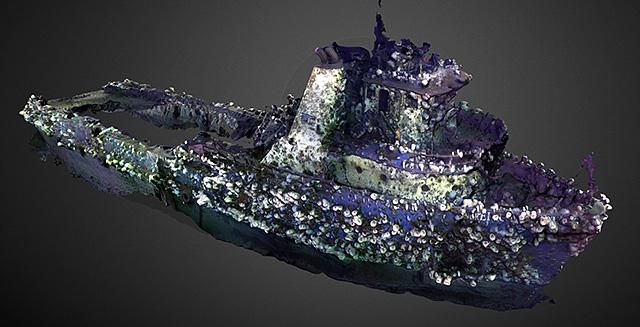He Was on Duty When the Ship Sank. Two Decades Later, the ROV Pilot Aids in Its Exploration
You can now explore a 3-D model of the wreck of the American Heritage
/https://tf-cmsv2-smithsonianmag-media.s3.amazonaws.com/filer/df/57/df574a71-ad01-42ca-9b18-e8c7916a484a/ah-wreck-bow-d1084-500.jpg)
A few miles south of Malibu, a scuttled supply boat lies some 2,300 feet below the surface of the Santa Monica Bay. Dubbed the American Heritage, the sunken ship’s exact location proved elusive following its May 4, 1995, descent to the seafloor. But in May 2018, David Grossman reports for Popular Mechanics, researchers from the Monterey Bay Aquarium Research Institute (MBARI) chanced upon the wreck site while conducting a routine survey of the bay.
Relatively unremarkable in life—Grossman notes that the ship’s loss was viewed as more of a “financial burden than a tragedy,” likely because all six crew members survived the incident—the American Heritage has assumed a new role in death, becoming a thriving artificial reef home to hundreds of deep-sea sponges and other marine creatures.
In the years following the sinking, the boat was largely forgotten. MBARI researchers spotted the wreckage during a 2008 survey but discounted it as an “anomaly,” according to a press release. The nearly 200-foot-long wreck was finally added to the maps in May 2018 using new surveys, but the wreck remained unexplored until a September 2018 expedition led by MBARI geologist Charles Paull, who was joined by Knute Brekke, one of MBARI’s chief ROV pilots.
Brekke had a keen interest in visiting the site. Although the exact nature of the scuttled ship remained unclear prior to the September venture, he had a hunch: On the night of the wreck in 1995, Brekke was actually on duty for American Pacific Marine, the diving and ROV company that owned the American Heritage. As he recounts in a press release, Brekke and his co-workers attempted to aid the vessel in distress, but it sank before they could even leave port.
“The propeller shaft separated and there was water coming through a six-to-eight-inch hole in the engine room,” Brekke explains. “And down it went.”
For MBARI, he decided to map the American Heritage’s projected route and discovered that it directly intersected with the position of the unidentified wreck.
“I may know what boat this is,” Brekke reportedly told the rest of the team.
Writing for Popular Mechanics, Grossman notes that this suspicion was confirmed after the researchers deployed their ROVs to take a closer look. Out of the depths, a series of letters appeared: A, M, E and R.
“That’s it,” Brekke’s co-pilot Ben Erwin said. “It says American Heritage.”

MBARI spokesperson Kim Fulton-Bennett tells Mindy Weisberger of Live Science that the American Heritage was responsible for “shuttling crews and supplies to and from offshore oil rigs,” as well as offering support to divers and ROVs tasked with maintaining oil rigs and seafloor pipelines.
Brekke and Erwin spent three hours guiding an ROV called “Doc Ricketts” through the wreck site during the September expedition. According to Weisberger, the images captured during this endeavor later enabled Erwin to build a 3-D model now available online. Although floating ropes and murky water prevented the team from exploring every corner of the wreckage, the digitized ship still offers an unparalleled glimpse of a unique underwater ecosystem. The diagram even features the resplendent purple, blue and green hues of its new residents.
Many shipwrecks get a new lease on life as homes for sea creatures when they sink to the depths. As Melissa Hobson notes for Ecophiles, the world’s oceans host thousands of sunken ships-turned-artificial reefs, many of which are accessible to both experienced and novice scuba divers. Try visiting the wreck of Russian tanker Ashkhabad, which was torpedoed by a German U-boat off the coast of North Carolina in 1942 and now hosts an array of coral, barracudas and stingrays, or perhaps the Australian S.S. Yongala, which sank in 1911 and is surrounded by schools of fish, sea turtles, and, on occasion, even bull sharks.
/https://tf-cmsv2-smithsonianmag-media.s3.amazonaws.com/accounts/headshot/mellon.png)
/https://tf-cmsv2-smithsonianmag-media.s3.amazonaws.com/accounts/headshot/mellon.png)